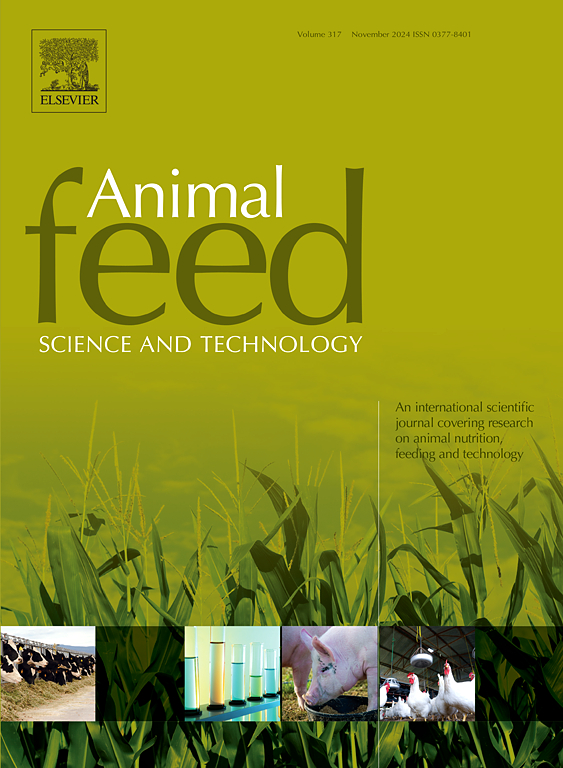氨基酸分析采用多时间点水解和非线性回归法测定生物标准、奶牛乳汁、组织、瘤胃微生物和各种饲料的氨基酸谱和21小时校正因子
IF 2.5
2区 农林科学
Q1 AGRICULTURE, DAIRY & ANIMAL SCIENCE
引用次数: 0
摘要
过去几年公布的数据表明,牛奶和其他底物的氨基酸(AA)浓度在标准的21-24 h水解期(用于将蛋白质分解成其成分AA)后没有得到正确的描述,并且某些AA可能需要更长的或更短的水解时间。本研究旨在通过多时间点水解和非线性回归,确定反刍动物组织、牛奶、微生物和饲料中AA的组成,建立最佳AA谱,并建立单时间点水解的校正因子。采用该方法对16种饲料、9种牛组织样品、8种牛奶样品和6种瘤胃微生物样品进行氨基酸分析,以反映蛋白质的供给和需求来源。底物通过HPLC-UV和/或HILIC-TQMS在110 °C的块式加热器中水解10-14个不同的时间点,从2到360 h,使用酸和碱水解。水解后,采用最小二乘非线性回归法测定氨基酸的真实含量。所有底物的许多AA在24 h结束后继续释放,并且观察到它们都下降了360 h。支链AA (BCAA)、Ser、Thr和Trp由于水解损失或不完全恢复而需要最高的校正,但大多数AA根据蛋白质来源有一定的校正。由此得出结论,目前反刍动物底物中AA的浓度被低估了。校正因子因蛋白质底物而异,Ala、Arg、Asp、Glu、Trp和Val的校正因子呈趋势或显著差异(P ≤ 0.10)。蛋白质特异性因子可以帮助改进AA配方,从而更好地预测营养供应和需求。本文章由计算机程序翻译,如有差异,请以英文原文为准。
Amino acid analysis using multiple time point hydrolysis and non-linear regression for determination of amino acid profiles and 21-hour correction factors of biological standards, and dairy cattle milk, tissue, rumen microbes, and various feeds
Data published over the last few years has demonstrated that the amino acids (AA) concentrations of milk and other substrates was not correctly described after the standard 21–24 h hydrolysis period, used to break down protein into its constituent AA, and that longer or shorter hydrolysis times might be needed for certain AA. The study objective was to determine the AA composition of ruminant tissue, milk, microbes, and feeds using multiple time-point hydrolysis and non-linear regression to establish optimal AA profiles and develop correction factors for single time-point hydrolysis. The AA were analyzed using this approach on sixteen feeds, nine cattle tissue samples, eight milk samples, and six ruminal microbial samples to represent both supply and requirement protein sources. Substrates were analyzed by HPLC-UV and/or HILIC-TQMS following hydrolysis at 110 °C in a block heater for 10–14 different time points ranging from 2 to 360 h using acid and alkaline hydrolysis. Following hydrolysis, least-squares non-linear regression was used to determine the true AA content. Many AA of all substrates continued to be released after the 24 h endpoint and were all observed to be declining by 360 h. The branched-chain AA (BCAA), Ser, Thr and Trp were found to need the highest correction due to hydrolysis loss or incomplete recovery, but most AA had some correction depending on the protein source. This leads to the conclusion that there is currently an underestimation of the AA concentration in ruminant substrates. Correction factors varied among protein substrates and trended or were significantly different for Ala, Arg, Asp, Glu, Trp, and Val (P ≤ 0.10). Protein-specific factors could help improve AA formulation for improved predictions of nutrient supply and requirements.
求助全文
通过发布文献求助,成功后即可免费获取论文全文。
去求助
来源期刊

Animal Feed Science and Technology
农林科学-奶制品与动物科学
CiteScore
6.00
自引率
6.20%
发文量
266
审稿时长
3 months
期刊介绍:
Animal Feed Science and Technology is a unique journal publishing scientific papers of international interest focusing on animal feeds and their feeding.
Papers describing research on feed for ruminants and non-ruminants, including poultry, horses, companion animals and aquatic animals, are welcome.
The journal covers the following areas:
Nutritive value of feeds (e.g., assessment, improvement)
Methods of conserving and processing feeds that affect their nutritional value
Agronomic and climatic factors influencing the nutritive value of feeds
Utilization of feeds and the improvement of such
Metabolic, production, reproduction and health responses, as well as potential environmental impacts, of diet inputs and feed technologies (e.g., feeds, feed additives, feed components, mycotoxins)
Mathematical models relating directly to animal-feed interactions
Analytical and experimental methods for feed evaluation
Environmental impacts of feed technologies in animal production.
 求助内容:
求助内容: 应助结果提醒方式:
应助结果提醒方式:


